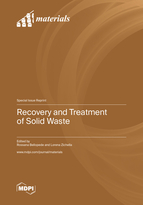Recovery and Treatment of Solid Waste
A special issue of Materials (ISSN 1996-1944). This special issue belongs to the section "Energy Materials".
Deadline for manuscript submissions: closed (20 March 2023) | Viewed by 44159
Special Issue Editors
Interests: raw and waste materials; circular economy; processing; solid characterization
Special Issues, Collections and Topics in MDPI journals
Interests: recycling; sustainability; sustainable development; environmental engineering; materials engineering
Special Issues, Collections and Topics in MDPI journals
Special Issue Information
Dear Colleagues,
The recovery of solid waste is a challenge and an opportunity for companies, thanks to the ongoing awareness of sustainability and technological advances. The end-of-waste criteria is a European strategic goal that promotes recycling, to ensure a high level of environmental protection by means of quantities reduction of waste destined for disposal.
This Special Issue aims to promote the knowledge of technological methods for solid waste recovery. Papers are invited to investigate innovative processing methods with the goal of valorizing solid waste form different civil and industrial activities. Topics may include studies on construction and building, mining, plastic, WEEE referring to the treatment techniques used and, where appropriate, the critical raw materials that can be valorised. The recovery processes of critical raw materials can be very energy-intensive, affecting environmental and soil aspects. Case studies on sustainable, low carbon and resource-efficient development for the purpose of a more competitive economy are also very welcome. The environmental impact and safety measures, especially for dangerous waste, should be taken into account in the description of their processing and management.
Prof. Dr. Rossana Bellopede
Dr. Lorena Zichella
Guest Editors
Manuscript Submission Information
Manuscripts should be submitted online at www.mdpi.com by registering and logging in to this website. Once you are registered, click here to go to the submission form. Manuscripts can be submitted until the deadline. All submissions that pass pre-check are peer-reviewed. Accepted papers will be published continuously in the journal (as soon as accepted) and will be listed together on the special issue website. Research articles, review articles as well as short communications are invited. For planned papers, a title and short abstract (about 100 words) can be sent to the Editorial Office for announcement on this website.
Submitted manuscripts should not have been published previously, nor be under consideration for publication elsewhere (except conference proceedings papers). All manuscripts are thoroughly refereed through a single-blind peer-review process. A guide for authors and other relevant information for submission of manuscripts is available on the Instructions for Authors page. Materials is an international peer-reviewed open access semimonthly journal published by MDPI.
Please visit the Instructions for Authors page before submitting a manuscript. The Article Processing Charge (APC) for publication in this open access journal is 2600 CHF (Swiss Francs). Submitted papers should be well formatted and use good English. Authors may use MDPI's English editing service prior to publication or during author revisions.
Keywords
- circular economy
- secondary raw materials
- end-of-waste
- waste recovery
- waste processing
- energy resources
- solid waste management
- environmental impact








